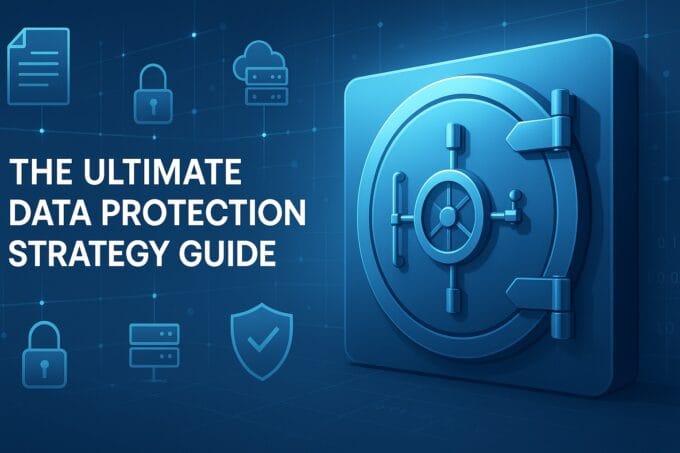Welcome to 2025. In our increasingly digital world, life online offers incredible convenience and connection. But with every step forward in technology, there’s a shadow – the growing threat of cyber fraud. I’m here to help you understand this complex issue, from what cyber fraud truly is to how you can protect yourself and your business, and most importantly, what to do if you become a victim. It’s not just about knowing the risks; it’s about empowering ourselves with the knowledge to fight back against digital deception.
Table of Contents
Key Insights
- Cyber fraud is digital deception: It involves using the internet and technology to trick people into giving up money, information, or access, and it’s a major threat in 2025.
- Many forms, one goal: From phishing emails to elaborate investment scams and even automated click fraud, cyber criminals aim to exploit trust and vulnerabilities for financial gain.
- Prevention is key: Strong passwords, multi-factor authentication, being skeptical of unsolicited requests, and regular software updates are crucial defenses.
- Know how to report: If you suspect or experience cyber fraud, act quickly by contacting your bank, local law enforcement, and relevant government agencies like the FBI’s IC3 (in the US) or Action Fraud (in the UK).
- Stay informed and vigilant: Cyber threats are always evolving, especially with advancements in AI, so continuous learning about new scams and best practices in cyber hygiene is vital for everyone.
What is Cyber Fraud? Defining the Digital Deception
When we talk about “what is cyber fraud,” we’re essentially discussing a type of crime where criminals use computers, the internet, and other digital technologies to trick people or organizations. Their goal? To gain money, personal information, or access to systems illegally. Think of it as traditional fraud, but with a modern, digital twist. Instead of a con artist knocking on your door, they’re sending you a convincing email, setting up a fake website, or even calling you with a spoofed number.
In 2025, cyber fraud isn’t just a minor annoyance; it’s a sophisticated and widespread problem affecting millions globally. It leverages our reliance on digital communication and online services. From banking to shopping, social media to professional networking, almost every aspect of our lives now has a digital footprint that can be exploited.
The core of cyber fraud lies in deception. Criminals don’t usually hack into your bank account directly (though data breaches can lead to fraud). Instead, they trick you into giving them the keys. This might involve convincing you to reveal your password, download malicious software, or authorize a fraudulent transaction. It’s a psychological game as much as a technological one.
“Cyber fraud preys on trust and urgency. It’s not just about technology; it’s about human behavior and our natural inclination to respond quickly.”
Cyber Fraud vs. General Fraud: What’s the Difference?
While all cyber fraud is a type of fraud, not all fraud is cyber fraud.
- General Fraud refers to any intentional deception made for personal gain or to damage another individual. This could be anything from faking an injury for insurance money to selling counterfeit goods in person.
- Cyber Fraud, specifically, requires the use of digital technology to commit the act. The internet, email, fake websites, malicious software, and social media are the tools of the trade. Without a digital component, it’s just regular fraud.
For example, someone trying to cash a forged check at a bank is general fraud. Someone sending you a fake email from your bank asking you to “verify” your account details is cyber fraud. The digital element is the defining characteristic. This distinction is important because it dictates the methods of prevention, detection, and reporting.
The Many Faces of Cyber Fraud: Common Types You Need to Know
Cyber fraud isn’t a single type of crime; it’s a vast umbrella covering numerous deceptive practices. Understanding these different forms is the first step in recognizing and avoiding them.
1. Phishing, Smishing, and Vishing
These are perhaps the most common types of cyber fraud. They involve criminals trying to trick you into revealing sensitive information by pretending to be someone trustworthy.
- Phishing: Uses fake emails or websites. You might get an email that looks exactly like it’s from your bank, asking you to click a link and “update your account details.” That link leads to a fake website designed to steal your login information.
- Smishing: The same concept as phishing, but using SMS (text messages). You might receive a text about a fake delivery notification or a problem with your bank account, urging you to click a link or call a number.
- Vishing: Uses voice calls. Criminals might pretend to be from your bank, a government agency, or a tech support company, trying to scare or convince you into giving them personal details or access to your computer.
- For more specific examples of these tactics, especially via messaging apps, you can read about WhatsApp and SMS scams.
2. Identity Theft
This occurs when criminals steal your personal information (like your Social Security number, bank account details, or driver’s license number) to impersonate you. They might open new credit accounts, file fake tax returns, or make unauthorized purchases in your name. This often starts with phishing, data breaches, or even physical theft of documents.
3. Online Shopping Scams
With the boom in e-commerce, these scams are rampant.
- Fake Websites: Criminals create professional-looking online stores selling popular products at unbelievably low prices. You pay, but never receive the item.
- Non-Delivery Scams: You buy from a legitimate-looking seller on a marketplace, but they never ship the product.
- Overpayment Scams: You’re selling an item, and the buyer sends you a check for more than the agreed price, asking you to wire back the difference. The original check is fake, and you lose the wired money.
4. Investment Scams
These schemes promise high returns with little to no risk. They often involve fake cryptocurrencies, exotic assets, or “get rich quick” schemes. They might use sophisticated websites, fake testimonials, and high-pressure sales tactics. By 2025, many of these are becoming increasingly convincing, sometimes leveraging AI-generated personas.
5. Tech Support Scams
You receive an unsolicited call or see a pop-up message on your computer claiming to be from a well-known tech company (like Microsoft or Apple), warning you about a serious virus or technical issue. They then try to convince you to grant them remote access to your computer or pay for unnecessary “fixes” or software.
6. Romance Scams
Criminals create fake online profiles on dating sites or social media, build emotional relationships with victims, and then invent crises (medical emergencies, travel problems, business failures) to ask for money. These scams can be devastating, both financially and emotionally.
7. Business Email Compromise (BEC)
This is a highly sophisticated scam targeting businesses. Criminals hack into or spoof an employee’s email account (often a CEO or CFO) and send fraudulent emails to other employees (like accounts payable), instructing them to transfer money to a fraudulent account or send sensitive data.
This list isn’t exhaustive, but it covers the most prevalent types of cyber fraud we encounter. Each one relies on a combination of technical trickery and psychological manipulation.
Unmasking Click Fraud in Cybersecurity
Beyond the types of fraud that directly target individuals for their money or data, there’s another insidious form of cyber fraud that significantly impacts businesses: click fraud. When we ask “what is click fraud in cyber security,” we’re delving into a specific form of digital deception that drains advertising budgets and distorts analytics.
Click fraud primarily affects businesses that use pay-per-click (PPC) advertising, such as Google Ads or social media ads. In PPC, advertisers pay a fee each time their ad is clicked. Click fraud happens when a person, an automated script, or a bot program clicks on a PPC ad with no genuine interest in the product or service being advertised.
How Click Fraud Works
- Bots and Automated Scripts: The most common method involves sophisticated bots designed to mimic human behavior. These bots repeatedly click on ads, making it appear as if legitimate users are engaging with the advertisement.
- Competitor Sabotage: A competitor might intentionally click on your ads to deplete your advertising budget quickly, hoping your ads will disappear, giving them more visibility.
- Fraudulent Publishers: Websites that host ads might use click fraud to artificially inflate their earnings. They get a share of the revenue each time an ad on their site is clicked, so fake clicks mean more money for them.
- Malware: Sometimes, malware installed on a user’s computer can secretly click on ads in the background without the user’s knowledge.
Impact on Businesses and Advertisers
The consequences of click fraud are significant:
- Wasted Ad Spend: Businesses pay for clicks that generate no leads, sales, or genuine interest, effectively throwing money away.
- Skewed Data: Fraudulent clicks distort advertising performance metrics, making it difficult for businesses to assess the effectiveness of their campaigns and make informed decisions.
- Reduced ROI: The return on investment for advertising campaigns plummets, impacting profitability.
- Reputation Damage: In some cases, if ads are associated with fraudulent activities or appear on low-quality sites due to click farms, it can indirectly harm a brand’s reputation.
Detection Methods
While click fraud is challenging to combat entirely, several methods are used for detection:
- IP Address Analysis: Identifying multiple clicks from the same IP address in a short period.
- Behavioral Analysis: Looking for non-human click patterns, such as extremely fast clicks, clicks at odd hours, or clicks that don’t lead to any further engagement on the website.
- Referral Source Tracking: Identifying suspicious referral sources or traffic from known bot networks.
- Specialized Software: Many cybersecurity firms offer dedicated shadow AI detection and anti-click fraud solutions that use advanced algorithms and machine learning to identify and block fraudulent activity.
Understanding click fraud is crucial for any business investing in online advertising. It’s a silent drain on resources that often goes unnoticed until significant damage has been done.
Understanding Fraud in Cybersecurity: A Broader Perspective
Beyond the specific types of cyber fraud and click fraud, it’s important to grasp “what is fraud in cyber security” from a broader perspective. This involves understanding how cybersecurity principles and practices are fundamental to preventing a vast array of digital frauds. Cybersecurity isn’t just about protecting against hackers; it’s also about building robust defenses that make it harder for fraudsters to succeed.
The Interconnection of Cybersecurity and Fraud Prevention
Many types of fraud, even those not directly initiated by a cyber attack, are often enabled or exacerbated by weaknesses in cybersecurity.
- Data Breaches: A major source of identity theft and subsequent fraud. When a company’s systems are breached, personal data (names, addresses, credit card numbers, Social Security numbers) can be stolen. This stolen data is then used by fraudsters to open accounts, make purchases, or impersonate individuals. Strong cybersecurity measures, including encryption, access controls, and vulnerability management, are essential to prevent these breaches.
- Weak Authentication: If systems rely on weak passwords or lack multi-factor authentication (MFA), fraudsters can more easily gain unauthorized access to accounts. Once inside, they can initiate fraudulent transactions or steal information.
- Malware and Ransomware: While often associated with data disruption, malware can also be a tool for fraud. Keyloggers can steal login credentials, and banking Trojans can intercept financial transactions. Ransomware can disrupt business operations, potentially leading to financial losses that fraudsters might exploit.
- Lack of Employee Training: Human error remains a leading cause of successful cyber fraud. Employees who aren’t trained to recognize phishing emails or social engineering tactics can inadvertently give criminals access to systems or sensitive information. This is why continuous cyber hygiene training in 2025 is so important for every organization.
- Insecure Systems: Outdated software, unpatched vulnerabilities, and misconfigured systems create openings for fraudsters. Whether it’s exploiting a flaw in a payment processing system or taking over an unsecure server, weak points are always attractive targets. This is especially critical in sectors like industrial control systems (ICS), where robust cybersecurity in industrial control systems is paramount to prevent fraud and disruption.
The Role of Robust Security in Preventing Fraud
A strong cybersecurity posture acts as a comprehensive shield against fraud.
- Layered Defenses: Implementing multiple layers of security (firewalls, intrusion detection, antivirus, email filters) makes it harder for fraudsters to penetrate systems.
- Access Management: Strict controls over who can access what information, combined with regular audits, limit opportunities for internal fraud or external compromise.
- Incident Response: Having a plan in place for how to react to a cyber incident can significantly limit the damage from a fraudulent attack, allowing for quick containment and recovery.
- Threat Intelligence: Staying updated on the latest fraud tactics and cyber threats helps organizations proactively strengthen their defenses.
- AI in Cybersecurity: Artificial intelligence is playing an increasingly critical role in detecting fraudulent patterns and anomalies that human analysts might miss. AI can analyze vast amounts of data to identify suspicious transactions, unusual login attempts, or even sophisticated phishing campaigns. To learn more, check out the role of artificial intelligence in modern cyber security.
Ultimately, a strong cybersecurity framework is not just about protecting data; it’s about protecting assets, finances, and trust by making it incredibly difficult for fraudsters to achieve their goals.
Why Are We Still Falling For It? Common Tactics Used by Cyber Criminals
Despite widespread warnings, people and businesses continue to fall victim to cyber fraud. Why? Because cyber criminals are masters of manipulation, constantly evolving their tactics to exploit human nature and technological vulnerabilities.
1. Social Engineering: The Art of Deception
This is the cornerstone of most cyber fraud. Social engineering involves tricking people into giving up confidential information or performing actions they wouldn’t normally do. Criminals play on powerful human emotions:
- Fear: “Your account will be suspended if you don’t act now!” They create a sense of urgency and panic, hoping you’ll bypass your critical thinking.
- Greed: “Congratulations, you’ve won a lottery! Just pay a small fee to claim your prize.” The promise of easy money can blind people to obvious red flags.
- Curiosity: “Check out these embarrassing photos of you!” Or, “Someone mentioned you in this post.” These messages tempt you to click malicious links.
- Helpfulness/Trust: “I’m from tech support, and your computer has a virus.” Or, “I’m a soldier overseas needing help.” They build rapport or authority to gain your trust.
- Authority: Pretending to be a CEO, a government official, or law enforcement to demand compliance.
These tactics make people suspend their judgment, often leading them to click a dangerous link, open an infected attachment, or reveal sensitive information.
2. Exploiting Vulnerabilities (Software & Human)
Criminals don’t just rely on social engineering; they also actively seek out weaknesses:
- Software Vulnerabilities: Outdated operating systems, web browsers, or applications often have known security flaws. Criminals exploit these “holes” to install malware, steal data, or gain unauthorized access. Regular updates patch these vulnerabilities, which is why they are so important.
- Human Vulnerabilities: This relates back to social engineering. Lack of awareness, fatigue, or simply being too busy can make individuals more susceptible to clever scams. A well-crafted phishing email sent at the end of a long workday might be more successful than one sent first thing in the morning.
3. Advanced Persistent Threats (APTs)
Some cyber fraud is part of much larger, more sophisticated campaigns. APTs are ongoing, stealthy attacks where an unauthorized user gains access to a network and stays there undetected for a long period. They might slowly gather information, learn company procedures, and then launch a highly targeted fraud, like a BEC scam, using inside knowledge. These are often backed by well-funded groups, sometimes even nation-states.
4. Impersonation and Spoofing
Modern technology makes it easier for criminals to impersonate legitimate entities:
- Email Spoofing: Sending emails that appear to come from a trusted source by faking the sender’s address.
- Website Cloning: Creating nearly identical copies of legitimate websites to trick users into entering their credentials.
- Caller ID Spoofing: Making their phone calls appear to originate from a legitimate company or government agency.
- Deepfakes: With advancements in AI, criminals can now create realistic fake audio or video of individuals, which can be used in vishing or BEC scams to convince victims they are speaking to a trusted person.
These tactics highlight that cyber fraud isn’t just about simple tricks anymore. It’s an evolving landscape where criminals leverage technology and psychology to achieve their illicit goals.
The Real-World Impact: Who Gets Hurt by Cyber Fraud?
Cyber fraud isn’t a victimless crime. Its effects ripple out, causing significant damage to individuals, businesses, and even the broader economy.
Individuals: Financial Loss and Emotional Distress
For individuals, the impact of cyber fraud can be devastating:
- Financial Ruin: Victims can lose their life savings, retirement funds, or money set aside for education. Recovering these funds is often difficult, if not impossible.
- Identity Theft: Dealing with identity theft is a long, arduous process. It can involve months or even years of trying to clear your name, correct credit reports, and regain control of your financial life.
- Emotional Trauma: Beyond the financial loss, victims often experience profound emotional distress. Feelings of shame, embarrassment, anger, and betrayal are common. Trust in online interactions can be shattered, leading to anxiety and isolation.
- Time and Effort: The process of reporting fraud, contacting banks, and attempting to recover losses consumes an enormous amount of time and energy.
Businesses: Reputation Damage, Financial Loss, and Legal Issues
Businesses face an even broader spectrum of harm from cyber fraud:
- Direct Financial Loss: This can come from fraudulent transactions, stolen funds via BEC scams, or the cost of recovering from a data breach that led to fraud. Click fraud, as we discussed, directly drains advertising budgets.
- Reputation Damage: A company that falls victim to cyber fraud, especially if it results in a data breach, can suffer severe damage to its reputation. Customers lose trust, leading to a decline in sales and loyalty. Rebuilding trust is a long and expensive process.
- Operational Disruption: Fraudulent activities can disrupt normal business operations, requiring resources to be diverted to investigation and recovery rather than core activities.
- Legal and Regulatory Fines: Depending on the nature of the fraud and the data involved, businesses might face hefty fines from regulatory bodies (e.g., GDPR, CCPA) if customer data was compromised due to inadequate security.
- Increased Insurance Premiums: Businesses that experience cyber fraud incidents may see their cyber insurance premiums for companies protecting your business in 2025 increase significantly.
- Loss of Intellectual Property: In some sophisticated fraud schemes, criminals might steal valuable trade secrets or intellectual property, giving competitors an unfair advantage.
Economy: Eroding Trust and Hindering Innovation
On a larger scale, cyber fraud undermines the digital economy:
- Erosion of Trust: Widespread cyber fraud makes consumers and businesses more hesitant to engage in online transactions, stifling e-commerce and digital innovation.
- Increased Costs: The financial burden of fraud detection, prevention, and recovery adds costs across industries, which can ultimately be passed on to consumers.
- Resource Diversion: Significant resources (human and financial) that could be used for productive innovation are instead diverted to fighting cyber crime.
- Global Impact: Cyber fraud doesn’t respect borders. It’s a global problem that requires international cooperation to combat, adding complexity to law enforcement efforts.
The impact of cyber fraud is far-reaching, affecting not just the immediate victims but the entire ecosystem of digital trust and commerce.
How to Protect Yourself and Your Business in 2025
Protecting yourself and your business from cyber fraud in 2025 requires a proactive, multi-layered approach. It’s not about being paranoid, but about being smart and cautious online.
For Individuals:
- Strong, Unique Passwords & Multi-Factor Authentication (MFA):
- Use long, complex passwords for all your accounts.
- Never reuse passwords. Consider a password manager.
- Always enable MFA (also known as two-factor authentication or 2FA) wherever possible. This adds an extra layer of security, usually a code sent to your phone, making it much harder for fraudsters to access your accounts even if they have your password.
- Be Skeptical: Verify, Don’t Trust:
- Think before you click. If an email or text seems suspicious, don’t click on any links or open attachments.
- Verify the sender. If you receive an unexpected request from a bank, government agency, or even a friend asking for money or information, contact them directly using a known phone number or email address (not the one provided in the suspicious message).
- Look for red flags: Poor grammar, unusual sender addresses, urgent demands, and generic greetings are common signs of scams.
- Keep Software Updated:
- Regularly update your operating system, web browser, antivirus software, and all applications. These updates often include critical security patches that fix vulnerabilities criminals exploit.
- Backup Your Data:
- Regularly back up important files to an external hard drive or a secure cloud service. This protects you against data loss from ransomware or other attacks.
- Monitor Your Accounts:
- Regularly check your bank statements, credit card statements, and credit reports for any suspicious activity. Report anything unusual immediately.
- Use a VPN on Public Wi-Fi:
- Public Wi-Fi networks are often insecure. Use a Virtual Private Network (VPN) to encrypt your internet traffic when connecting to public hotspots.
- Be Careful What You Share Online:
- Criminals can use information from your social media profiles (birthdays, pet names, family details) to guess passwords or answer security questions. Limit the personal information you share publicly.
For Businesses:
- Employee Training and Awareness:
- Regularly educate employees about the latest cyber fraud tactics, especially phishing, BEC, and social engineering. Conduct simulated phishing exercises.
- Emphasize the importance of strong passwords and MFA.
- Robust Cybersecurity Infrastructure:
- Implement strong firewalls, intrusion detection systems, and endpoint protection.
- Ensure all software and systems are regularly patched and updated.
- Consider using some of the best free cybersecurity tools every IT professional should know to bolster your defenses.
- Data Protection and Encryption:
- Encrypt sensitive data both in transit and at rest.
- Implement strict access controls, ensuring only authorized personnel can access critical information.
- Multi-Factor Authentication (MFA) Across the Board:
- Enforce MFA for all employee logins, especially for accessing sensitive systems, cloud services, and email.
- Incident Response Plan:
- Develop and regularly test a comprehensive incident response plan for how to handle a cyber fraud incident, including communication protocols, data recovery, and legal considerations.
- This includes building ICS cyber resilience: building business continuity beyond firewalls for industrial systems.
- Regular Audits and Vulnerability Assessments:
- Periodically audit your systems and conduct penetration testing to identify and address security weaknesses before criminals can exploit them.
- Cyber Insurance:
- Invest in comprehensive cyber insurance for companies protecting your business in 2025 to mitigate the financial impact of a successful attack.
- Strong Internal Controls:
- Implement financial controls such as requiring multiple approvals for large money transfers to prevent BEC scams. Separate duties to reduce the risk of internal fraud.
By adopting these practices, both individuals and businesses can significantly reduce their vulnerability to cyber fraud in 2025.
How to Report Cyber Fraud: Taking Action Against Digital Criminals
If you suspect you’ve been a victim of cyber fraud, acting quickly is crucial. The faster you respond, the better your chances of limiting the damage and potentially recovering losses. Knowing “how to report cyber fraud” is just as important as knowing how to prevent it.
Immediate Steps to Take:
- Stop All Communication: Immediately cease all contact with the suspected fraudsters. Do not send any more money or provide any more information.
- Preserve Evidence:
- Take screenshots of emails, text messages, social media profiles, or websites used by the fraudsters.
- Save any relevant documents, transaction records, or communications.
- Note down dates, times, and any names or contact details used.
- Contact Your Bank or Financial Institution:
- If money was sent or compromised, or if your bank account/credit card details were exposed, call your bank immediately. Explain the situation and ask them to freeze accounts, cancel cards, or reverse transactions if possible.
- Many banks have dedicated fraud departments available 24/7.
- Change Passwords:
- If you provided any passwords to the fraudsters or if you suspect an account has been compromised, change those passwords immediately. Use strong, unique passwords and enable MFA.
- Secure Your Devices:
- Run a full scan with reputable antivirus/anti-malware software on any device you believe might have been compromised (e.g., if you clicked a suspicious link or downloaded an attachment).
- Consider disconnecting the device from the internet until you’re sure it’s clean.
Where to Report Cyber Fraud: Key Agencies and Resources
Once you’ve taken immediate steps to secure your finances and information, it’s time to report the crime to the appropriate authorities. Knowing “where to report cyber fraud” can vary depending on your location and the nature of the fraud.
In the United States:
- Internet Crime Complaint Center (IC3): This is the primary federal agency for reporting cyber crime, including cyber fraud. I highly recommend filing a detailed report with the FBI’s IC3. They compile complaints and refer them to appropriate law enforcement agencies for investigation.
- Federal Trade Commission (FTC): Report identity theft and other frauds to the FTC. They also provide resources and guidance for victims of identity theft.
- Local Law Enforcement: Report the crime to your local police department. While they may not have specialized cyber crime units, they can create a police report, which can be essential for disputes with banks or credit bureaus.
- Credit Bureaus: If your personal information was compromised, contact the three major credit bureaus (Equifax, Experian, and TransUnion) to place a fraud alert or freeze on your credit report.
- Equifax: 1-888-766-0008
- Experian: 1-888-397-3742
- TransUnion: 1-800-680-7289
- Social Security Administration (SSA): If your Social Security number was compromised, report it to the SSA.
In the United Kingdom:
- Action Fraud: This is the UK’s national reporting center for fraud and cyber crime. You can report online or by calling 0300 123 2040. They will provide you with a crime reference number.
- National Cyber Security Centre (NCSC): While not a reporting agency for individual crimes, the NCSC provides excellent guidance and resources on staying safe online.
- Your Bank: As in the US, contact your bank immediately if financial accounts are affected.
Other Countries and General Advice:
- National Cyber Crime Reporting Portals: Many countries have their own dedicated portals for reporting cyber crime. For example, if you’re in India, you would report through the government’s National Cybercrime Reporting Portal. This portal is designed to help citizens report all types of cyber fraud and cyber scams in India.
- Europol (Europe): For citizens within the European Union, Europol coordinates efforts against cyber crime.
- Internet Service Provider (ISP): Report phishing emails or malicious websites to your ISP.
- Website/Platform: If the fraud occurred on a specific platform (e.g., a social media site, an online marketplace), report the scammer’s profile or activity to that platform.
“Reporting cyber fraud isn’t just about seeking justice for yourself; it’s about providing data that helps law enforcement track down criminals and prevent future crimes.”
Remember, reporting is a critical step in the fight against cyber fraud. It helps authorities understand the scope of the problem, identify trends, and allocate resources to apprehend criminals.
Looking Ahead: The Future of Cyber Fraud in 2025 and Beyond
The landscape of cyber fraud is constantly evolving, driven by technological advancements and the ingenuity of criminals. In 2025, we’re seeing new trends emerge, and it’s essential to understand what’s on the horizon to stay one step ahead.
Emerging Threats:
- AI-Powered Scams and Deepfakes: Artificial intelligence is a double-edged sword. While it enhances cybersecurity defenses, criminals are also leveraging AI to create more sophisticated and convincing scams.
- Deepfake Audio/Video: AI can generate incredibly realistic fake audio and video of individuals. This means a fraudster could call you with an AI-generated voice of your CEO, a family member, or a government official, making highly convincing vishing or BEC attacks possible. Imagine getting a video call from your “boss” asking you to urgently transfer funds.
- AI-Generated Phishing: AI tools can create perfectly worded, grammatically correct, and highly personalized phishing emails that are almost indistinguishable from legitimate communications.
- AI-Enhanced Bots: Click fraud and other automated scams will become even more sophisticated, with bots mimicking human behavior so precisely that traditional detection methods struggle to identify them.
- Metaverse and Web3 Fraud: As the metaverse and Web3 technologies (like NFTs and decentralized finance) become more mainstream, new avenues for fraud will open up.
- NFT Scams: Fake NFTs, rug pulls, and phishing attempts targeting crypto wallets are already prevalent and will likely increase.
- Virtual Land Scams: Deceptive schemes involving the sale of non-existent or overvalued virtual land.
- Decentralized Finance (DeFi) Exploits: Vulnerabilities in smart contracts or decentralized applications can lead to significant financial losses.
- Quantum Computing Threats (Longer Term): While not an immediate threat in 2025, the development of quantum computers poses a long-term risk to current encryption methods. If quantum computers become powerful enough, they could break many of the cryptographic algorithms that secure our online communications and transactions. This highlights the importance of research into post-quantum cryptography to develop new, quantum-resistant encryption standards.
The Need for Continuous Vigilance and Evolving Defenses
Given these evolving threats, our approach to combating cyber fraud must also adapt:
- Continuous Education: Individuals and businesses must commit to ongoing education about new scam tactics. What worked for criminals last year might be old news next year.
- Adaptive Security Solutions: Cybersecurity solutions need to be dynamic, leveraging AI and machine learning themselves to detect and respond to novel threats.
- Collaboration: Stronger collaboration between law enforcement, cybersecurity firms, financial institutions, and international bodies is crucial to share threat intelligence and coordinate responses.
- Policy and Regulation: Governments will need to develop new policies and regulations to address AI-driven fraud and protect consumers in emerging digital environments like the metaverse.
- Personal Responsibility: Ultimately, a significant part of the defense lies with each one of us. Our skepticism, our commitment to strong security practices, and our willingness to report incidents will be key factors in limiting the success of cyber criminals.
The battle against cyber fraud is an ongoing one. By staying informed, remaining vigilant, and embracing new protective measures, we can collectively build a safer digital future in 2025 and beyond.
Bottom Line
In 2025, cyber fraud is an undeniable and ever-present threat in our digital lives. From the cunning tricks of phishing emails and elaborate investment scams to the hidden drain of click fraud on businesses, the methods of digital deception are vast and constantly evolving. I hope this comprehensive guide has shed light on “what is cyber fraud,” the various forms it takes, and the significant impact it can have on individuals and businesses alike.
The good news is that knowledge is your most powerful weapon. By understanding the common tactics used by cyber criminals, practicing strong cyber hygiene, and knowing exactly “how to report cyber fraud” and “where to report cyber fraud,” you empower yourself to navigate the online world with greater confidence and security. Let’s commit to staying vigilant, protecting our digital footprints, and working together to build a safer online environment for everyone.












Leave a comment